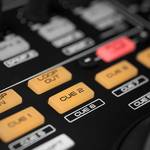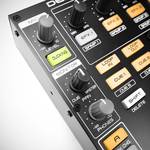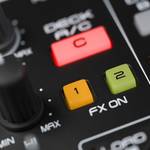Denon MC-3000 Price at launch: £399 – Link: Denon DJ
Table of Contents
Introduction
Denon’s MC-3000 is a compact Traktor controller that can control four channels despite having only two faders. Not only that, it also has line-only timecode support, which means you can easily hook up two CDJs to control the decks of NI’s legendary software, and it also has the usual complement of hot-cues, FX controls and sample triggers.
It seems great value at just £399, but there are some good-quality controllers at the more affordable end of the market, such as Pioneer’s DDJ-Ergo and NI’s excellent Traktor S2, so why should you consider the Denon MC-3000?
Read Mark’s view on the Denon DJ Prime set up now available
Ins and Outs
The MC-3000’s I/O is refreshingly simple, providing only the bare minimum of I/O that you need to support an unashamedly all-in-one controller. There’s a single 6.3mm headphone output, a 6.3mm microphone input, balanced outputs on 6.3mm jacks, two stereo RCA inputs and a type B USB port. The chief benefit of this frugal I/O is the ability to remember the location of everything quickly and find the I/O you need just by feeling along the back panel, which is handy if you’re the sort of person that prefers simple setups.
Mixer Section
The mixer section looks and behaves like the mixer section of many Traktor controllers. It has two channel faders, a crossfader, and two Cue buttons. Although it only has two channel faders, you can switch between decks using two Deck buttons next to the gain controls. This means that you can control Deck C’s volume using the left-hand fader, press the Deck button and then use the fader to control Deck A’s volume. Doing so feels natural, and the Deck button’s illumination provides an obvious visual cue that reminds you which deck you currently control.
The system uses ‘soft-takeover’ to prevent volume-based mishaps, which means you have to return the fader to the position its virtual counterpart occupies on screen in order for it to work. This system takes a bit of getting used to if you’ve never used it before, but you do soon get used to it.
The crossfader is fairly loose and has a similar feel to Numark’s RS-45 crossfader, the type fitted in mixers such the M4. Don’t panic, though – we’re purely talking about the feel here, not longevity. The crossfader isn’t too bad for scratching, but even though you can pull off some decent techniques it isn’t very satisfying because the response isn’t as fast as the crossfader on the Traktor S4. This isn’t helped by the slower response of the jog wheel, either.
The central peak meter LEDs can be set to either deck or master. In Deck mode, the left LED strip depicts the audio level of deck A or C and the right deck depicts the level of Deck B or D. In Master mode, the audio level of the Master is depicted. It has seven chunky segments that do an excellent job of depicting the audio level. It quickly responds to changes in gain and is very informative. This makes it an entirely useable feature that can be relied upon.
No mixer section would be complete without a set of EQ pots. The Denon MC-3000 pots are plastic, but their stems are metal, which gives added confidence in their longevity and their ability to take a bit of high-pressure abuse in the heat of an intense mix. In keeping with modern tradition, the EQs are arranged in a line with the pot closest to the faders being the filter and the pot at the top being the gain control.
As is typical, the MC-3000 has a 3-band EQ section and each pot has a centre detent. The gain and filter pots are a different colour to the EQ pots, which is a good thing because you never get confused and accidentally twist the filter when you meant to twist the bass pot. Their movement is smooth, and you can quickly twist them to your desired position.
In all, the MC-3000’s mixer section is successful and is a pleasant platform from which to mix.
Decks
If you’ve ever used a controller or CDJ before, you’ll be able to use the MC-3000’s decks. The layout is simple and uncomplicated. The jog wheel itself is 105mm (around four inches) in diameter. The platters are touch-sensitive, and you can scratch tracks when the Vinyl Mode button is switched on.
Personally, I found the jog wheel to be too small and too light to make scratching enjoyable. This isn’t helped by the looser integration that the MC-3000 has with Traktor in comparison to the Kontrol S4, and the jog wheels have a definite lag that has nothing to do with latency settings and everything to do with the way third-party controllers control Traktor. Sadly, you have to compensate for it, and it makes performing techniques such as chirps more difficult and tiresome than it should be.
Even in Vinyl Mode, the side of the jog wheel can be used to speed up or slow down a track in order to get it in phase with other tracks. The Denon MC-3000 also has a pair of Pitch Bend buttons on each deck, a welcome luxury that Denon always affords its decks. These are an excellent alternative to moving the jog wheel, and if you press the Shift button you can use the buttons to move through a track quickly. If you prefer not to use the jog wheels, you can ‘lock’ them so that they have no effect on track playback.
You get the obligatory cue and play buttons too, and these work like those on any other deck. When you press the Shift and Cue buttons together, you go straight back to the start of a track, which is incredibly handy.
The pitch fader is exceptionally smooth and works as you’d expect, but it has a centre detent with a bit of dead space around it. This means it can be difficult to make ultra-fine adjustments to a track’s pitch if, for example, you have one track running at 127BPM and another running at 127.2BPM. You could argue that you can simply press Sync to match the beats automatically or move the jog every once in a while to compensate, but you don’t always want to do that.
Sample Controls
There’s nothing fiddly or awkward about the MC-3000’s sample controls. To use the samples, you simply press the Sampler button. The EFX buttons then activate the sample slots and the FX pots control the volume of the sample. If you use the Shift key, the EFX buttons become filter switches and the pots control the level of the filter. This is a brilliant system, and it gives you clean and precise means of controlling Traktor’s sample players.
Effects Controls
The effects controls follow the now well-established pattern of four pots above four buttons. In Traktor, the method of control depends on whether or not that FX bank is in Advanced or Chained mode. In Advanced mode, for example, the left-most button switches the effect on and off, the left-most pot controls the Dry/Wet control and the rest control individual parameters. The buttons are chunky, making them easy to hit in a rush when your mind is on other matters, and the pots are decently spaced.
Loop Controls
The loop buttons are also chunky and are comprised of loop in and out buttons, an auto-loop button, and two buttons for controlling the length of the auto-loop. The greatest strength of this setup is, once again, simplicity and the ease with which these controls can be brought to bear. Their bright illumination and chunky size make it easy to hit and control them.
Having two buttons to control an auto-loop instead of a pot makes it easier to increase or decrease an auto-loop more accurately (it’s easy to twist a pot too far, producing a 1/16 loop instead of ¼ loop, for example), but it also means that you can’t go from one extreme to another quickly, something that’s easily done if you’re using a pot.
Sadly, the loop controls aren’t perfect because some the buttons can become wedged under the fascia of the MC-3000, completely ruining your mix.
Hot-Cues
Like the loop controls, the hot-cues are big, chunky and well illuminated, and can become wedged under the MC-3000’s fascia. They work in the same way as hot-cue buttons on other controllers, with lit buttons triggering pre-set hot-cue points when pressed, unlit buttons setting hot-cue points when pressed and Shift and a lit button deleting hot-cue points when pressed.
Conveniently, the Denon MC-3000 has a button underneath the four hot-cue buttons that lets you use four more hot-cue points. In normal use, the four hot-cue buttons trigger the first four hot-cues in your software, but they can be used to set and trigger the last four hot-cue points this button is pressed. It’s a toggle switch, so you don’t have to keep it pressed to use the extra cue points. This button makes it easy to use the extra hot-cues quickly and conveniently.
Denon MC-3000 Global Controls
The MC-3000 has global controls between the EQ strips. These controls include Forward and Back buttons, four other push buttons, and a Crossfader Mode button. Their function depends on the context and whether the Shift button is used. For example, the Back button loads the highlighted track into Traktor’s Preview Player when pressed with the Shift button, and the Forward button starts and stops the Preview Player. In Virtual DJ, the Crossfader Mode button allows control of audio, video, or both with the crossfader for customized video mixing.
In Virtual DJ, the Crossfader Mode button lets you control just audio, just video or both audio and video with the crossfader, which means you can tailor the crossfader to your own preferred method of video mixing.
Auxiliary Inputs
The Denon MC-3000 has line-level auxiliary inputs that bypass the main mixer controls completely. Instead, you pan between them using a pot, with the first set of inputs being to the left of the pot and the second set of inputs to the right. The effect is like fading between a cued channel and the master with a PFL pot.
Sadly, you can’t cue the auxiliary inputs individually, which means you can’t use this system to mix if your laptop malfunctions, and there’s only one volume pot for the auxiliary system anyway. Still, it’s a better auxiliary system than is seen on a lot of controllers at this price and it means you do have some method of fading between tracks should your laptop have a strop.
You can also route the line inputs through Traktor as a live input, so that you can use the MC-3000’s mixer section to mix audio from those sources.
Timecode Control
The Denon MC-3000 was tested with Traktor Scratch Pro 2 and I could use a pair of CDJs to control Traktor via timecode. When using a sample buffer of 88, I only experienced the odd audio dropout, but the frequency of audio dropouts, pops and clicks increased when I started to apply lots of effects and tweaked the filters. This is to be expected, and increasing the size of the sample buffer made them less frequent. I feel that the S4 provides tighter timecode control, but when you consider the price of the MC-3000 it’s hard to complain.
Denon MC-3000 Conclusion
At first glance, the Denon MC-3000 looks like a typical me-too controller, but it isn’t. Denon has taken a different approach in a number of areas, such as the auto-loop controls and the auxiliary input controls, making the MC-3000 a true alternative to other controllers.
The build quality of the MC-3000 is also top-notch for the price, the possibility of certain buttons getting stuck under the fascia aside. Its line inputs and ability to control Traktor via control CDs also mark it out as a good buy for this money, as does its non-reliance on a single DJing application.
Denon has such belief in this product that it asked us to compare the MC-3000 to the Kontrol S4, and that wasn’t a casual act of bravado. We reckon the Kontrol S4 has more to offer the Traktor user than the MC-3000, but the MC-3000 is considerably cheaper and gives you the option of adding timecode-toting CD players at a later date, should you want them. If you don’t have the money for the Kontrol S4, you should check out the MC-3000.
It makes more sense to compare the Denon MC-3000 to the DDJ-Ergo-V and Kontrol S2. It’s certainly better value than the DDJ-Ergo-V and has better perceivable build quality, feeling nowhere near as plasticky. It’s much harder to recommend it over the Kontrol S2 if you’re a Traktor user, though. Both units have high-resolution jog wheels, but the S2’s jog wheels have much tighter integration with Traktor and much better response. In the end, it all comes down to which unit better suits your style and the software you use. The MC-3000 isn’t an also-ran controller. It’s an excellent device in its own right.
Ratings
Build Quality
Solid build quality, but some buttons get caught under the MC-3000’s fascia, ruining mixes.
Sound Quality
Great sound quality for a controller of this price, but the software you use also has a bearing on sound quality. If you use poor-quality MP3s you get poor-quality audio.
Features and Implementation
It has all the controls you need and expect on a controller of this type, but the implementation of some controls, such as the auto-loop buttons, distinguish it from other controllers.
Value For Money
It has two line inputs through which you can route timecode and two software systems that you can use out of the box for £399, which makes it great value for money.
Bottom Line
The Denon MC-3000 implements its controls in such a sufficiently unique way that it gives consumers more choice beyond a brand name. It also has two line-inputs, can play music if your laptop has stopped working (although you can’t mix the two line inputs properly should the laptop fail) and comes with two different software systems. Its jog wheels work, but this is a controller for pulling off creative, innovative mixes and isn’t for hardcore turntablists looking to ditch their 1210s.
It’s great value at its current price and should be given serious consideration if you need a high-quality, affordable controller.
A Right To Reply
A new feature of the DJWORX reviews is offering the manufacturer a chance to add their voice to the reviews. It’s only fair, and give them a chance to comment on our feelings.
In the case of the MC-3000, Denon felt that the review was balanced and fair, but wanted to address a couple of points raised. Firstly the buttons under the faceplate issue – Denon have experienced instances of this with different buttons to us, and have already put changes into production, thus this issue should be fixed.
They also acknowledge some of the shortcomings of the jogwheel with the current Traktor mapping and will have a revised one ready with explanatory PDF.
Gallery






















